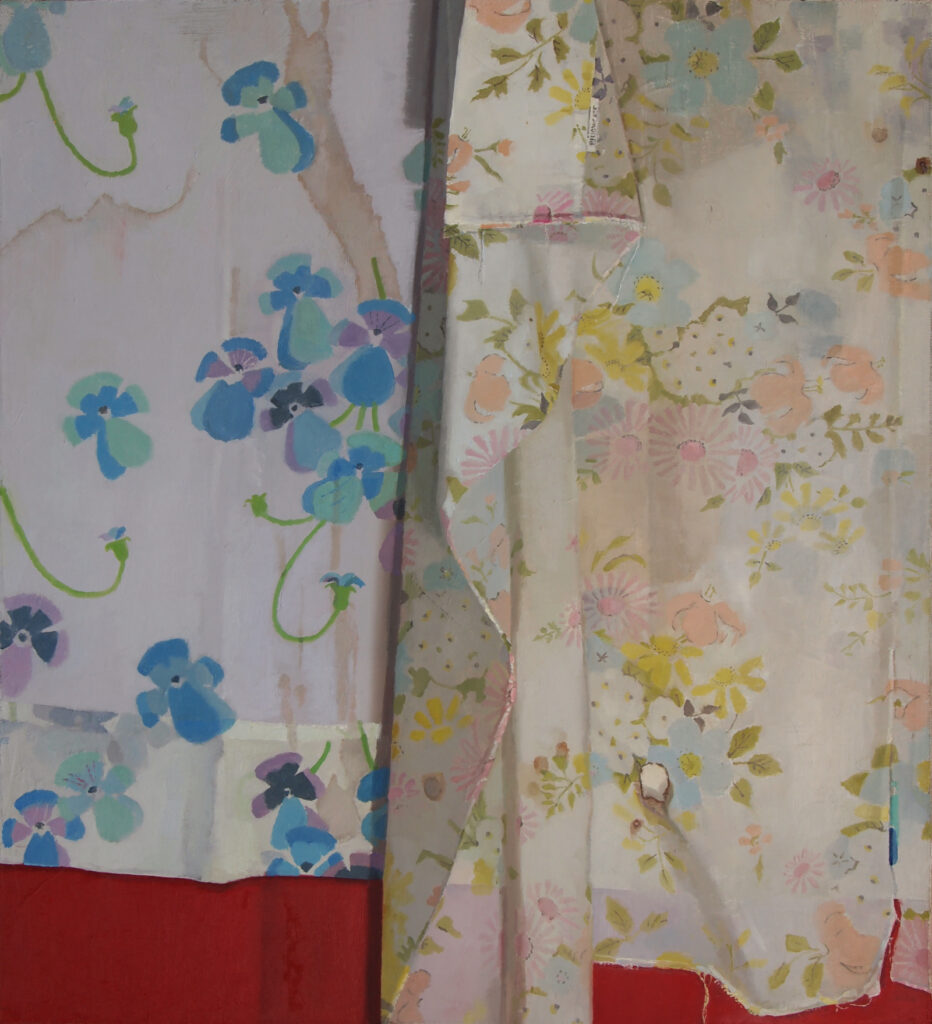Opportunity in the overlooked

Laid Down, Erin Raedeke, oil on canvas
I first noticed Erin Raedeke’s paintings when she was a member at First Street Gallery in Chelsea some years ago and was immediately charmed by her handling of color. Her delicate, playful images of birthday party detritus, strewn across the field of view, gave her endless ways to improvise with tones that created deeply felt, personal color harmonies. The work was representational but also “all over,” without the negative space typical in a still life, the objects in the foreground against an empty background. The work was fine-tuned, with attention to unique details, but gracefully and effortlessly executed. If she worked from photographs, it didn’t show. My first thought was that Fairfield Porter would love the work. Nothing is overdone; the paintings appear to be first responses to whatever she sees without much going back over earlier marks. I saw her work again in 2015 at a group show curated by Matt Klos at Anne Arundel Community College. The painting in that show was simpler and harder to read, but still executed in the same steady, quiet and idiosyncratically personal insistence on representing humble objects in recognizable space in order to come up with results as close to abstraction as representation.
Her birthday party images give her an ample and varied palette of hues—almost any color can be made to fit into an image. Conical hats and flaccid balloons could be strewn across a surface to create patterns and shapes at will, though she was sedulous about keeping her subjects as random-looking, as “found” as possible. Departing from the party leftovers, she has used layered fabrics to create quasi-minimalist abstractions, some almost as radically simplified as Rothko or a Barnett Newman zip. The top layer of fabric would be torn or punched in places to reveal the color or pattern of what was underneath. Some of these paintings were as large as five feet tall, adding to their sense of kinship with abstracts from the mid-20th century. Yet even in this flat, minimal work, Raedeke has been just as diligent in capturing factual detail—the frayed tendrils of thread bristling from a torn edge running across a canvas as demarcation between large areas of nearly uniform color. She has an insistence on rendering lines as thin as spiderweb. Such minute detail in a sea of color seems like a pyrrhic effort to pull back from the larger strategy of enveloping the viewer—but it works. Oh, OK, we’re looking at cloth. There is something compulsive in this, in the way that much of what’s best in a particular artist’s style represents a surrender to inarticulate instincts about what needs to happen simply to make a picture come alive. Yet that adherence to minor detail makes even these larger, more amorphous paintings approachable, humble, amiable—when you recognize what’s been represented they snap back into insignificance, studies of what nearly anyone else wouldn’t even have bothered to notice. The fabric even looks a little stained.
Her recent work is included in Manifest’s Painted, and it seems like a culmination, in a way, of what she’s been doing over the past decade, from the versatile color of her birthday party messes to the almost ascetic renunciations of the fabric paintings where she seems to want to improvise as simply as possible with color and form and space and yet still show you something you might actually see on the surface of a bed or countertop. She’s sticking with fabric, but there’s more depth—and the patterns of this fabric give her room to vary color and line and shape It hangs like a curtain, and its decorative print gives the painter a way of bringing back the musical tones. In this case, it’s just a pair of muslin sheets, it seems, decorated with floral patterns, a scattering of blue pansies on the cool side of the painting. The fabric hangs in supple folds, against a deep red background that shows as a slash of color at the bottom, beneath the hems. It’s as humble and unspectacular as possible, but the patterns are rendered with care, almost gratitude for the opportunities they offer.
The particular integrity she brings to her work shines through in this insistence on painting nothing but what she sees—even if it’s merely the torn edge of monotone, porous cloth—in order to create a nearly flat field of color. If you allow for varying degrees of flatness, this is a pursuit common to countless painters, but she brings a lyrical, almost wistful quality to her images, as if she’s nostalgic for the moment, a few seconds ago, that she last glanced at her subject. And in the work I enjoy the most from her, the impression of flatness gives way to depth—albeit the shallow relief of curtains or layers of wrapping paper under a half-eaten hamburger. They’re fragments of a larger experience, not signifying anything but rather saturated with her sense of how life feels.
Comments are currently closed.